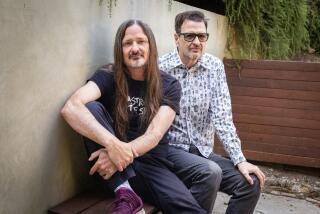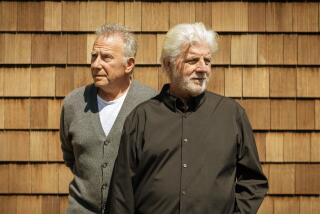McDonald So Predictable in Takin’ It to the Coach House
Michael McDonald certainly has more than his fair share of raw vocal talent. His voice is a human stereo loudspeaker, with a tweeter throwing out high, plaintive tones, and a woofer simultaneously adding throaty body.
This distinctive mix has brought McDonald some success on his own over the past six years, and before that it brought him a great deal of success as the singer who turned the Doobie Brothers from a slick country-rock act into slick pop-soul hit-makers. It also has made him an in-demand duet singer for the likes of Patti LaBelle and James Ingram.
But judging from his sold-out early show Friday at the Coach House in San Juan Capistrano, McDonald got shortchanged on another quality that’s as important for a pop singer as ability: imagination.
Opening a two-night stand, McDonald and his six-man band played it strictly by the numbers. Their 80-minute set included a sampling of songs from McDonald’s two solo albums--the most recent of which came out almost three years ago--and a liberal helping of crowd-pleasing tunes he originally sang for the Doobies, done just like the records.
Like all convention-bound acts, McDonald saved the biggest hits for the end, finishing his pre-encore set with three of the Doobies’ most popular songs: “Minute By Minute,” “What a Fool Believes” and “Takin’ It to the Streets.” The surest sign of a pop artist striving to keep his act fresh is the placement of must-play hits early in a set. That lets the performer satisfy an audience’s legitimate desire to hear its favorites and then move into more adventurous territory. McDonald’s set had all the venturesomeness of morning calisthenics or a trip to the bank.
The lack of new material made one wonder whether McDonald has been on vacation for the past two years. If not, he simply lacked the gumption, or the confidence in his fans, to challenge an audience with something new. Even McDonald’s encore rendition of “When a Man Loves a Woman,” though beautifully sung, was so faithful to the Percy Sledge original that it failed to register a big chill--or even a little one.
Another drawback was the sameness of McDonald’s material and his vocal approach. Most of his songs are based on a rhythmic keyboard hook, then layer smooth, high backing vocals over his husky, high lead. He and his band executed that formula capably, but after a while it began to sound . . . formulaic.
One exception was “Bad Times,” in which McDonald’s convincing pleading was supported by stormy instrumental backing. The other change of pace from a narrow range of uptempo pop-R&B; was the ballad, “I Can Let Go Now,” in which only a string synthesizer accompanied McDonald and his piano. It might have been interesting to hear McDonald continue in that spare format while introducing a few new songs in their barest form. Or, like Joe Jackson, a lesser vocalist but a far more imaginative performer, he might have tried recasting one of his familiar hits in stripped-down form.
Limiting himself to a few bland comments and forced quips between songs, McDonald didn’t betray much personality. Somehow, given the by-the-book tenor of the entire performance, that wasn’t too surprising.
More to Read
The biggest entertainment stories
Get our big stories about Hollywood, film, television, music, arts, culture and more right in your inbox as soon as they publish.
You may occasionally receive promotional content from the Los Angeles Times.











